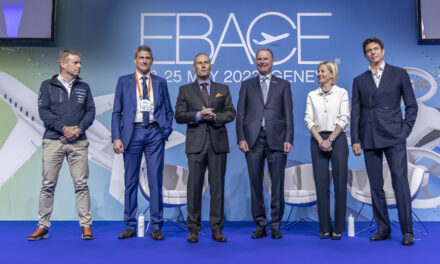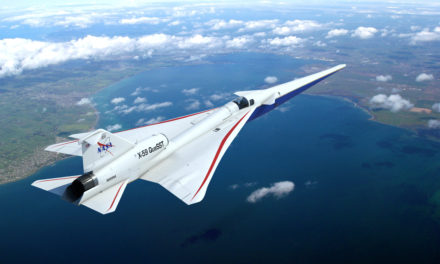On December 13, Dassault announced through a press release the cancellation of its Falcon 5X program. The reason, the development of the Safran Silvercrest engine which had been plagued by repeated delays. A look back at the chaotic program and dashed hopes.
“Dassault Aviation initiates the termination process of the Silvercrest contract leading to the end of the Falcon 5X program and announces the launch of a new Falcon program with an entry into service in 2022”. The first lines of Dassault’s press release cut straight to the chase. However, beyond these words the end of the program is a true tragedy for Dassault’s engineers who have been working on the aircraft since 2007 – and rightly so. The twinjet was hailed as the renewal of the Falcon family in light of its direct competition from Gulfstream in a particularly heated market which has become increasingly challenging over the years.
A visionary aircraft
Launched during the 2013 NBAA trade show, the Falcon 5X was expected to breathe new life into the segment with the twinjet representing a condensed version the French firm’s latest technological developments. The aircraft featured a cabin volume of 50m3 along with the highest ceiling height ever designed for the business aviation segment (excluding converted commercial aircraft) at 1.98 meter. In addition to its 14 windows, the aircraft also featured a “Skylight” ceiling window. A first in business aviation. Aside from its innovative cabin design, the Falcon 5X was also equipped with a new digital flight control system. This system integrated for the first time all flight control surfaces including a “flaperon” located on the wing trailing edge which enabled the aircraft to perform steep approaches without increasing speed. The introduction of this flight control surface was implemented in addition to a new wing configuration. Dassault focused on developing a lighter ultra-efficient wing, abandoning the double arrow wing of the previous versions. Some other notable features included the integration of a third-generation EASy cockpit that was enhanced with a new Heads Up Display (HUD) system combining the Enhanced Vision System (EVS) and the Synthetic Vision System (SVS).
Difficult first scene
Dassault presented the Falcon 5X as a multi-mission aircraft capable of flying long distances – up to 5,200 nm/9,630 km – with 8 people on board as well as short inter-regional trips. With the aircraft representing such technological prowess, Eric Trappier, Chairman and CEO of Dassault Aviation stated in his speech presenting the aircraft that “The Falcon 5X is the new benchmark for the creative use of advanced technology in business aviation”. On paper, these performance figures were directly driven from its Safran Silvercrest engine under development. The engine maker was counting on the Falcon 5X to kick start its engine program and at the same time sell it to Cessna for the future Citation “Hemisphere”. Especially promising, with these two contracts Safran would march straight into the heart of business aviation. However, despite the lengthy engineering works by the Safran Aircraft Engines teams, the engine maker and the aircraft manufacturer announced a first delay in 2015 in the middle of the Ebace trade show and one month before the roll out of the aircraft. This first setback would result in a two-year delay from the initial schedule due to two major issues encountered by the engines manufacturer. The first concerning the thermal regulation and the oil-fuel thermal balance. An error that arose after the modeling phase automatically resulting in the complete redesign of certain parts and an industrialization process lasting several months. The second issue would arise in the integration of the engine on the flying testbed, a Gulfstream GII. The new schedule put forward by the engine maker therefore reflected its commitment to deliver the engines by the end of 2017 for the flight tests. On this basis, Dassault Aviation was obliged to push back the entry into service of the Falcon 5X by three years from 2017 to 2020. This announcement “raised concerns from clients” and led to the cancellation of orders for 12 aircraft in 2016. In light of the competition, the stakes were high but Dassault still believed in its program and would try everything to keep it alive.
Act II
Equipped with interim engines that did not comply with specifications, the Falcon 5X prototype took its first flight on July 5, 2017 from Dassault’s Bordeaux-Merignac site. The prototype would undergo a preliminary test campaign of around 50 hours revealing that the flight behavior met all the expectations. In the fall of 2017 during the NBAA trade show in Las Vegas, Safran Aircraft Engines announced that it had encountered new problems with the high-pressure compressor and had informed Dassault of an additional delay making it impossible to meet the entry into service of the aircraft by 2020. Eric Trappier reported that they were “trying to keep all options open”. But this would prove the last straw for the program. The French aircraft manufacturer announced the termination of the Silvercrest contract in December and with it the end of the program. All that can be said is that the announcement took its toll on Dassault’s teams. After repeated disappointments, any hope left was crushed. Aside from the team’s morale, Dassault must also deal with to a lesser extent the fallout of such an announcement in terms of its reputation. Even though it finds itself in the role of the victim. Accordingly, it is now starting to imagine that the negotiations initiated with Safran will certainly be “tight” in light of the damage incurred. As such, the engine maker stated in a press release “that contractual penalties applicable to the engine development phase have already been provisioned in its accounts”. Concerning the progress of the Silvercrest program, the subject still remains a sore point. However, the end of cooperation with Dassault does not yet mark the death knell for the program. At least for the time being since according to a Cessna representative the engine maker still seems to be on track to deliver to the American aircraft manufacturer on time. The upcoming months will prove decisive however for the engine maker.
The program benefits for Dassault
While the consequences of abandoning such a program are damaging in terms of reputation, nevertheless the five years of research and development have not been all for nothing. To the contrary. With the Falcon 8X launched seven months later, Dassault was working on two major programs in 2014 with €1.5 billion invested in these two models. A portion of the investment that as a result enabled the groundwork to be laid for Dassault’s industrial revolution. This includes the development and integration of new specific production tools such as the innovative pivoting wing assembly system. With the Falcon 5X, Dassault took a step forward in the field of industrial processes and automation. The approach referred to as Improved Production Responsiveness enables the optimization of various operations ranging from manufacturing to assembly of parts in addition to entirely digital documentation. The arrival of lean manufacturing within the aircraft manufacturer’s various units since 2015 as well as research into various technologies embedded on the Falcon 5X (flaperon, Skylight, Easy III, etc.) will automatically benefit the future model to be launched by Eric Trappier. Mentioned at the same time as the announcement of the end of the Falcon 5X program, the new Falcon according to the CEO will address “a strong market need for a brand new long range aircraft with a very large cabin”. He adds: “so I have decided to launch a new Falcon project powered by Pratt & Whitney Canada engines, featuring the same cross section as the Falcon 5X, a range of 5,500 Nm, and scheduled to enter into service in 2022”. A program that is expected to reinvigorate Dassault and produce an aircraft with remarkable performance. We’ll have to wait and see.
Another era, same story
Looking to the past, this was not the first time Dassault called off a civil program. In 1973, the aircraft manufacturer was working on a “larger” derivative of the Mystère XX capable of transporting 30 passengers. With this twinjet aircraft, Dassault was planning to enter the regional aviation market. At the same time, an “Executive” version for eight passengers was also being studied. After designing an initial prototype and beginning work on the second, Dassault was forced to stop development of the Falcon 30 due to its….engine. The program was called off as a result of the fuel inefficiency of the Lycoming engines combined with the oil shock at the time.
By Frédéric Vergnères
© photos : Dassault Aviation









